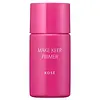What's inside
What's inside
 Key Ingredients
Key Ingredients

 Benefits
Benefits

 Concerns
Concerns

 Ingredients Side-by-side
Ingredients Side-by-side

Water
Skin ConditioningCyclomethicone
EmollientAlcohol Denat.
AntimicrobialTalc
AbrasiveSilica
AbrasiveDimethicone
EmollientDimethicone Crosspolymer
Emulsion StabilisingVinyl Dimethicone/Methicone Silsesquioxane Crosspolymer
PEG-9 Dimethicone
Skin ConditioningPEG-9 Polydimethylsiloxyethyl Dimethicone
EmulsifyingSodium Acetylated Hyaluronate
HumectantTocopherol
AntioxidantSodium Hyaluronate
HumectantProline
Skin ConditioningHydrolyzed Hyaluronic Acid
HumectantButylene Glycol
HumectantEthylhexyl Acrylate
Squalane
EmollientStearic Acid
CleansingTriethoxycaprylylsilane
Trimethylsiloxysilicate
EmollientWater, Cyclomethicone, Alcohol Denat., Talc, Silica, Dimethicone, Dimethicone Crosspolymer, Vinyl Dimethicone/Methicone Silsesquioxane Crosspolymer, PEG-9 Dimethicone, PEG-9 Polydimethylsiloxyethyl Dimethicone, Sodium Acetylated Hyaluronate, Tocopherol, Sodium Hyaluronate, Proline, Hydrolyzed Hyaluronic Acid, Butylene Glycol, Ethylhexyl Acrylate, Squalane, Stearic Acid, Triethoxycaprylylsilane, Trimethylsiloxysilicate
Cyclopentasiloxane
EmollientWater
Skin ConditioningZinc Oxide
Cosmetic ColorantButylene Glycol
HumectantTitanium Dioxide
Cosmetic ColorantPEG-9 Polydimethylsiloxyethyl Dimethicone
EmulsifyingDimethicone
EmollientPEG-10 Dimethicone
Skin ConditioningSilica
AbrasiveSilica Dimethyl Silylate
EmollientTrifluoropropyldimethyl/Trimethylsiloxysilicate
EmollientSodium Acetylated Hyaluronate
HumectantAnthemis Nobilis Flower Oil
MaskingSalvia Officinalis Leaf Extract
CleansingTocopherol
AntioxidantDipotassium Glycyrrhizate
HumectantHydrogenated Polyisobutene
EmollientPolymethylsilsesquioxane
Hydroxypropyl Cyclodextrin
MaskingAluminum Hydroxide
EmollientDimethicone/Vinyl Dimethicone Crosspolymer
Skin ConditioningMica
Cosmetic ColorantCitric Acid
BufferingSodium Citrate
BufferingRosa Damascena Flower Oil
MaskingEthylhexylglycerin
Skin ConditioningPhenoxyethanol
PreservativeIron Oxides
Cyclopentasiloxane, Water, Zinc Oxide, Butylene Glycol, Titanium Dioxide, PEG-9 Polydimethylsiloxyethyl Dimethicone, Dimethicone, PEG-10 Dimethicone, Silica, Silica Dimethyl Silylate, Trifluoropropyldimethyl/Trimethylsiloxysilicate, Sodium Acetylated Hyaluronate, Anthemis Nobilis Flower Oil, Salvia Officinalis Leaf Extract, Tocopherol, Dipotassium Glycyrrhizate, Hydrogenated Polyisobutene, Polymethylsilsesquioxane, Hydroxypropyl Cyclodextrin, Aluminum Hydroxide, Dimethicone/Vinyl Dimethicone Crosspolymer, Mica, Citric Acid, Sodium Citrate, Rosa Damascena Flower Oil, Ethylhexylglycerin, Phenoxyethanol, Iron Oxides
Ingredients Explained
These ingredients are found in both products.
Ingredients higher up in an ingredient list are typically present in a larger amount.
Butylene Glycol (or BG) is used within cosmetic products for a few different reasons:
Overall, Butylene Glycol is a safe and well-rounded ingredient that works well with other ingredients.
Though this ingredient works well with most skin types, some people with sensitive skin may experience a reaction such as allergic rashes, closed comedones, or itchiness.
Learn more about Butylene GlycolDimethicone is a type of synthetic silicone created from natural materials such as quartz.
What it does:
Dimethicone comes in different viscosities:
Depending on the viscosity, dimethicone has different properties.
Ingredients lists don't always show which type is used, so we recommend reaching out to the brand if you have questions about the viscosity.
This ingredient is unlikely to cause irritation because it does not get absorbed into skin. However, people with silicone allergies should be careful about using this ingredient.
Note: Dimethicone may contribute to pilling. This is because it is not oil or water soluble, so pilling may occur when layered with products. When mixed with heavy oils in a formula, the outcome is also quite greasy.
Learn more about DimethiconePEG-9 Polydimethylsiloxyethyl Dimethicone is a type of silicone.
Silica, also known as silicon dioxide, is a naturally occurring mineral. It is used as a fine, spherical, and porous powder in cosmetics.
Though it has exfoliant properties, the function of silica varies depending on the product.
The unique structure of silica enhances the spreadability and adds smoothness, making it a great texture enhancer.
It is also used as an active carrier, emulsifier, and mattifier due to its ability to absorb excess oil.
In some products, tiny microneedles called spicules are made from silica or hydrolyzed sponge. When you rub them in, they lightly polish away dead skin layers and enhance the penetration of active ingredients.
Learn more about SilicaSodium Acetylated Hyaluronate is a type of Hyaluronic Acid.
Hyaluronic Acids help moisturize, soothe, and protect the skin.
Read about common types of Hyaluronic Acid here:
Sodium Hyaluronate
Hydrolyzed Hyaluronic Acid
Hyaluronic Acid
Tocopherol (also known as Vitamin E) is a common antioxidant used to help protect the skin from free-radicals and strengthen the skin barrier. It's also fat soluble - this means our skin is great at absorbing it.
Vitamin E also helps keep your natural skin lipids healthy. Your lipid skin barrier naturally consists of lipids, ceramides, and fatty acids. Vitamin E offers extra protection for your skin’s lipid barrier, keeping your skin healthy and nourished.
Another benefit is a bit of UV protection. Vitamin E helps reduce the damage caused by UVB rays. (It should not replace your sunscreen). Combining it with Vitamin C can decrease sunburned cells and hyperpigmentation after UV exposure.
You might have noticed Vitamin E + C often paired together. This is because it is great at stabilizing Vitamin C. Using the two together helps increase the effectiveness of both ingredients.
There are often claims that Vitamin E can reduce/prevent scarring, but these claims haven't been confirmed by scientific research.
Learn more about TocopherolWater. It's the most common cosmetic ingredient of all. You'll usually see it at the top of ingredient lists, meaning that it makes up the largest part of the product.
So why is it so popular? Water most often acts as a solvent - this means that it helps dissolve other ingredients into the formulation.
You'll also recognize water as that liquid we all need to stay alive. If you see this, drink a glass of water. Stay hydrated!
Learn more about Water